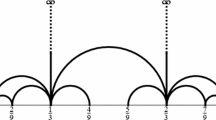Abstract
Haas–Molnar maps are a family of maps of the unit interval introduced by A. Haas and D. Molnar. They include the regular continued fraction map and A. Renyi’s backward continued fraction map as important special cases. As shown by Haas and Molnar, it is possible to extend the theory of metric diophantine approximation, already well developed for the Gauss continued fraction map, to the class of Haas–Molnar maps. In particular, for a real number x, if (p n /q n )n≥1 denotes its sequence of regular continued fraction convergents, set θ n (x) = q 2 n |x − p n /q n |, n = 1, 2.... The metric behaviour of the Cesàro averages of the sequence (θ n (x))n≥1 has been studied by a number of authors. Haas and Molnar have extended this study to the analogues of the sequence (θ n (x))n≥1 for the Haas–Molnar family of continued fraction expansions. In this paper we extend the study of \(({\theta _{{k_n}}}(x))\)n≥1 for certain sequences (k n )n≥1, initiated by the second named author, to Haas–Molnar maps.
Similar content being viewed by others
References
G. Alkauskas, “Transfer operator for the Gauss’ continued fraction map. I: Structure of the eigenvalues and trace formulas,” arXiv: 1210.4083v6 [math.NT].
K. I. Babenko, “On a problem of Gauss,” Dokl. Akad. Nauk SSSR 238 (5), 1021–1024 (1978) [Sov. Math., Dokl. 19, 136–140 (1978)].
K. I. Babenko and S. P. Jur’ev, “On the discretization of a problem of Gauss,” Dokl. Akad. Nauk SSSR 240 (6), 1273–1276 (1978) [Sov. Math., Dokl. 19, 731–735 (1978)].
A. Bellow, R. Jones, and J. Rosenblatt, “Convergence for moving averages,” Ergodic Theory Dyn. Syst. 10 (1), 43–62 (1990).
M. Boshernitzan, G. Kolesnik, A. Quas, and M. Wierdl, “Ergodic averaging sequences,” J. Anal. Math. 95, 63–103 (2005).
W. Bosma, H. Jager, and F. Wiedijk, “Some metrical observations on the approximation by continued fractions,” Indag. Math. 45, 281–299 (1983).
J. Bourgain, “On the maximal ergodic theorem for certain subsets of the integers,” Isr. J. Math. 61 (1), 39–72 (1988).
J. Bourgain (with an appendix jointly with H. Furstenberg, Y. Katznelson, and D. S. Ornstein), “Pointwise ergodic theorems for arithmetic sets,” Publ. Math., Inst. Hautes Étud. Sci. 69, 5–45 (1989).
R. M. Burton, C. Kraaikamp, and T. A. Schmidt, “Natural extensions for the Rosen fractions,” Trans. Am. Math. Soc. 352 (3), 1277–1298 (2000).
I. P. Cornfeld, S. V. Fomin, and Ya. G. Sinaĭ, Ergodic Theory (Springer, New York, 1982), Grundl. Math. Wiss. 245.
K. Dajani, C. Kraaikamp, and N. van der Wekken, “Ergodicity of N-continued fraction expansions,” J. Number Theory 133 (9), 3183–3204 (2013).
K. Gröchenig and A. Haas, “Backward continued fractions, Hecke groups and invariant measures for transformations of the interval,” Ergodic Theory Dyn. Syst. 16 (6), 1241–1274 (1996).
A. Haas, “Invariant measures and natural extensions,” Can. Math. Bull. 45 (1), 97–108 (2002).
A. Haas and D. Molnar, “Metrical diophantine approximation for continued fraction like maps of the interval,” Trans. Am. Math. Soc. 356 (7), 2851–2870 (2004).
A. Haas and D. Molnar, “The distribution of Jager pairs for continued fraction like mappings of the interval,” Pac. J. Math 217 (1), 101–114 (2004).
D. Hensley, “Continued fraction Cantor sets, Hausdorff dimension, and functional analysis,” J. Number Theory 40 (3), 336–358 (1992).
D. Hensley, “Metric Diophantine approximation and probability,” New York J. Math. 4, 249–257 (1998).
C. T. Ionescu Tulcea and G. Marinescu, “Théorie ergodique pour des classes d’opérations non complètement continues,” Ann. Math., Ser. 2, 52 (1), 140–147 (1950).
S. Lang, Introduction to Diophantine Approximations (Addison-Wesley, Reading, MA, 1966), Addison-Wesley Ser. Math.
D. H. Mayer, The Ruelle–Araki Transfer Operator in Classical Statistical Mechanics (Springer, Berlin, 1980), Lect. Notes Phys. 123.
D. Mayer and G. Roepstorff, “On the relaxation time of Gauss’s continued-fraction map. I: The Hilbert space approach (Koopmanism),” J. Stat. Phys. 47 (1–2), 149–171 (1987).
D. Mayer and G. Roepstorff, “On the relaxation time of Gauss’ continued-fraction map. II: The Banach space approach (transfer operator method),” J. Stat. Phys. 50 (1–2), 331–344 (1988).
R. Nair, “On polynomials in primes and J. Bourgain’s circle method approach to ergodic theorems. II,” Stud. Math. 105 (3), 207–233 (1993).
R. Nair, “On the metrical theory of continued fractions,” Proc. Am. Math. Soc. 120 (4), 1041–1046 (1994).
R. Nair, “On uniformly distributed sequences of integers and Poincaré recurrence. II,” Indag. Math., New Ser. 9 (3), 405–415 (1998).
R. Nair, “On metric Diophantine approximation and subsequence ergodic theory,” New York J. Math. 3A, 117–124 (1998).
R. Nair and M. Weber, “On random perturbation of some intersective sets,” Indag. Math., New Ser. 15 (3), 373–381 (2004).
H. Nakada, “Metrical theory for a class of continued fraction transformations and their natural extensions,” Tokyo J. Math. 4, 399–426 (1981).
S. M. Rudolfer and K. M. Wilkinson, “A number-theoretic class of weak Bernoulli transformations,” Math. Syst. Theory 7, 14–24 (1973).
D. Ruelle, “Dynamical zeta functions and transfer operators,” Notices Am. Math. Soc. 49 (8), 887–895 (2002).
D. Ruelle, Thermodynamic Formalism: The Mathematical Structures of Equilibrium Statistical Mechanics, 2nd ed. (Cambridge Univ. Press, Cambridge, 2004).
A. Tempelman, Ergodic Theorems for Group Actions: Informational and Thermodynamical Aspects (Kluwer, Dordrecht, 1992), Math. Appl. 78.
L. Vepštas, “The Gauss–Kuzmin–Wirsing operator,” http://67.198.37.16/math/gkw.pdf
P. Walters, An Introduction to Ergodic Theory (Springer, New York, 1981).
Author information
Authors and Affiliations
Corresponding author
Additional information
In memory of A. A. Karatsuba
Published in Russian in Trudy Matematicheskogo Instituta imeni V.A. Steklova, 2017, Vol. 299, pp. 170–191.
Rights and permissions
About this article
Cite this article
Ma, L., Nair, R. Haas Molnar Continued Fractions and Metric Diophantine Approximation. Proc. Steklov Inst. Math. 299, 157–177 (2017). https://doi.org/10.1134/S0081543817080119
Received:
Published:
Issue Date:
DOI: https://doi.org/10.1134/S0081543817080119




